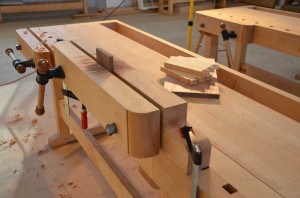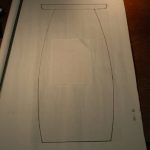We may receive a commission when you use our affiliate links. However, this does not impact our recommendations.
Lie-Nielsen’s heavy-duty chain-drive mechanism has recently been used to create two new vises from the Warren, Maine, tool manufacturer – a dovetailing vise and a leg vise.
I got a chance to use both new vises while in Maine in July, and am both impressed and convinced. By “impressed” I mean they are worthy of the Lie-Nielsen name. And by “convinced” I mean that I think the company’s chain-drive mechanism is a winner.
 I eschew complexity, especially when it comes to food, marriage and workbenches. So I’ve been a bit standoffish about the chain-drive mechanism, which I first saw about four years ago at Woodworking in America.
I eschew complexity, especially when it comes to food, marriage and workbenches. So I’ve been a bit standoffish about the chain-drive mechanism, which I first saw about four years ago at Woodworking in America.
But after using the mechanism a lot on the company’s Improved Workbench, I can find no fault with the way it functions, grips or endures hard use.
So take a gander at these two vises. The leg vise is available now. The dovetailing vise should be ready in about a month, according to Thomas Lie-Nielsen.
The Dovetailing Vise
Based somewhat on the Moxon-style vises, this heavy-duty brute features 18” between the screws, which makes it great for drawers and most casework. Both maple jaws are lined with leather and the chain mechanism clamps the work like a gator on a chicken leg.
You can buy the hardware for $285 or buy it with the jaws for $385.
The Leg Vise
Lie-Nielsen has been using this vise on its Roubo workbench, but it will also be available on the company’s Improved Workbench for an upcharge of $250. The chain-drive mechanism negates the need for a parallel guide or pin. In other words, it stops you from stooping.
It works very well. Surprisingly well.
If you want to add one to your workbench, the price for the hardware is $285. With the wooden chop, the price is $385.
Just five years ago, the complaint among bench builders was that there was almost no good bench hardware out there to choose from. Now there is so much good hardware that I regularly hear complaints about how they can’t choose.
— Christopher Schwarz
Interested in building a bench? Try these resources:
1. Everything I’ve written about workbenches on this blog since 2005. Click here.
2. Workbenchdesign.net.
3. These workbench books and videos I’ve written or been involved with.
Here are some supplies and tools we find essential in our everyday work around the shop. We may receive a commission from sales referred by our links; however, we have carefully selected these products for their usefulness and quality.











I’ve just started building a Roubo which will have a Veritas Twin Screw mounted as a leg vise. So I’m dead pleased to get some third party verification of the validity of the concept. 🙂
It seems a lot more straightforward than an X/scissors linkage.
Floating the idea on S/C several months ago didn’t bring up any feedback, so as far as i knew it was an original concept.
Leg vises have gained a lot of profile since I bought the Veritas to mount horizontally. The change of heart came when I started to lay out the drawing:
(1) Mounting the back jaw for a horizontal vise requires either a split jaw, or removing a big chunk from the top.
(2) The 4 3/8 in thick beech top was pushing the screws lower than seemed wise given the risk of tilting when clamping a piece at the top.
(3) The horizontal jaw takes up an enormous amount of bench frontage, even at the stock 16 7/8in screw spacing.
It fits nicely as a leg vise, in that the screws fall at a convenient spacing that doesn’t mess with the stretchers or the top.
It’s tough to find objective discussion of the pros and cons of a leg vise, so i’m not too sure what the downsides are – but it seems only a couple of years since horizontally mounted twin screws were the latest since sliced bread.
The major loss in going to a leg vise i could see seemed to be the ability to clamp wide boards for dovetailing. A Moxon seemed like the straightforward way around that.
The biggest potential issue i could see with mounting the Veritas vertically was that there’s a fair amount of slop in the fits of the screw in the nuts and jaw sleeves. It seemed like it might be no harm to tighten it up a bit to minimise any lateral wobbling..
I’m running with a UHMW bearing block in the leg at the back of the top screw, and with some bronze shim material in the jaw sleeve. Leaving the bottom screw fits stock, as it should minimise the risk of running into jamming issues while tightening due to any slight misalignment.
Not quite sure yet what to do about handles. It’s possible to fit a handwheel a la Benchcrafted, but I think I’ll try the stock handle first.
It seems that some minor (independent) adjustment of the bottom screw may be required for fine jaw alignment, but not major tightening – so maybe a very short handle or small wheel will work well there.
I’d appreciate any feedback you may have on the the above, or on the pros and cons of leg vises in particular….
Thanks
ian
“I eschew complexity, especially when it comes to food, marriage and workbenches.”
Preach it Brother!
The first photo does not add up? Where are the screws sticking out of the back? Did somebody cut them off?
Chris –
Can you close the dovetailing vise askew, or does the chain drive keep the jaws parallel?
Jonathan
================================
Well, I just shot an email over to my wife saying I need $3,885. Just waiting for a reply (whistling…).
I want a Lie-Nielsen bulletproof vest. That would be awesome. Screw Kevlar, I’ll take bronze any day.
It’s good to see an American company attempting to not only be innovatice, but also make their product better than everybody else, not cheaper. Good job.
So to retrofit a leg vise onto an existing bench, it looks like I have to build the chop, install the chain mech, and then drill two holes in my leg. Done. That seems like a pretty simple way to retrofit and existing bench. Unless I’m missing something this is exactly the type of thing I’ve been waiting for. Any thoughts?
-Shawn